Sustainability Approach: Case Study of Spice Girls Company's Issues
VerifiedAdded on 2020/05/01
|9
|2812
|41
Report
AI Summary
This report provides a comprehensive analysis of the sustainability approach of Spice Girls Company, addressing key challenges and opportunities across social, economic, environmental, and financial dimensions. The company faces issues related to production, including the relocation of its processing plant, chemical usage in plantations, and employee compensation and working conditions. Financial considerations involve cost minimization and risk management, particularly concerning the new factory setup in Buranda and investment in emission control systems. Environmental concerns center on the impact of chemicals and emissions from the Geelong plant, while social issues include employee morale and working conditions. The report explores the company's second problem involving emissions from the current Geelong plant, including air pollution and complaints from neighbors. The third problem focuses on low employee morale and conflicts in the Geelong plant. The report recommends gathering further information on costs, wages, chemical alternatives, government policies, health effects, and factors affecting employee motivation to inform effective sustainability strategies. The report provides a balanced view of the problems faced by Spice Girls Company when adopting a sustainable approach.

UNIT:
NAME:
DATE:
NAME:
DATE:
Paraphrase This Document
Need a fresh take? Get an instant paraphrase of this document with our AI Paraphraser
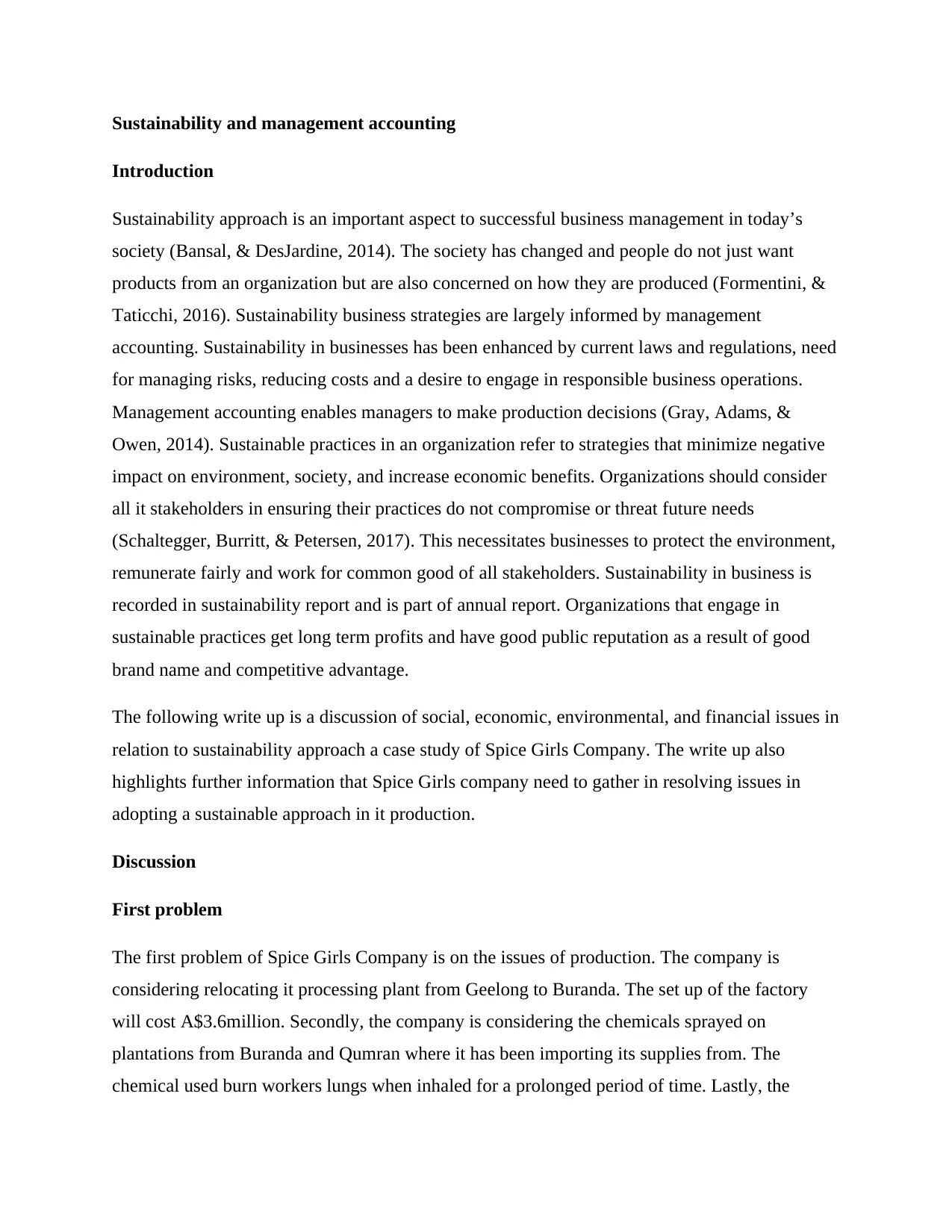
Sustainability and management accounting
Introduction
Sustainability approach is an important aspect to successful business management in today’s
society (Bansal, & DesJardine, 2014). The society has changed and people do not just want
products from an organization but are also concerned on how they are produced (Formentini, &
Taticchi, 2016). Sustainability business strategies are largely informed by management
accounting. Sustainability in businesses has been enhanced by current laws and regulations, need
for managing risks, reducing costs and a desire to engage in responsible business operations.
Management accounting enables managers to make production decisions (Gray, Adams, &
Owen, 2014). Sustainable practices in an organization refer to strategies that minimize negative
impact on environment, society, and increase economic benefits. Organizations should consider
all it stakeholders in ensuring their practices do not compromise or threat future needs
(Schaltegger, Burritt, & Petersen, 2017). This necessitates businesses to protect the environment,
remunerate fairly and work for common good of all stakeholders. Sustainability in business is
recorded in sustainability report and is part of annual report. Organizations that engage in
sustainable practices get long term profits and have good public reputation as a result of good
brand name and competitive advantage.
The following write up is a discussion of social, economic, environmental, and financial issues in
relation to sustainability approach a case study of Spice Girls Company. The write up also
highlights further information that Spice Girls company need to gather in resolving issues in
adopting a sustainable approach in it production.
Discussion
First problem
The first problem of Spice Girls Company is on the issues of production. The company is
considering relocating it processing plant from Geelong to Buranda. The set up of the factory
will cost A$3.6million. Secondly, the company is considering the chemicals sprayed on
plantations from Buranda and Qumran where it has been importing its supplies from. The
chemical used burn workers lungs when inhaled for a prolonged period of time. Lastly, the
Introduction
Sustainability approach is an important aspect to successful business management in today’s
society (Bansal, & DesJardine, 2014). The society has changed and people do not just want
products from an organization but are also concerned on how they are produced (Formentini, &
Taticchi, 2016). Sustainability business strategies are largely informed by management
accounting. Sustainability in businesses has been enhanced by current laws and regulations, need
for managing risks, reducing costs and a desire to engage in responsible business operations.
Management accounting enables managers to make production decisions (Gray, Adams, &
Owen, 2014). Sustainable practices in an organization refer to strategies that minimize negative
impact on environment, society, and increase economic benefits. Organizations should consider
all it stakeholders in ensuring their practices do not compromise or threat future needs
(Schaltegger, Burritt, & Petersen, 2017). This necessitates businesses to protect the environment,
remunerate fairly and work for common good of all stakeholders. Sustainability in business is
recorded in sustainability report and is part of annual report. Organizations that engage in
sustainable practices get long term profits and have good public reputation as a result of good
brand name and competitive advantage.
The following write up is a discussion of social, economic, environmental, and financial issues in
relation to sustainability approach a case study of Spice Girls Company. The write up also
highlights further information that Spice Girls company need to gather in resolving issues in
adopting a sustainable approach in it production.
Discussion
First problem
The first problem of Spice Girls Company is on the issues of production. The company is
considering relocating it processing plant from Geelong to Buranda. The set up of the factory
will cost A$3.6million. Secondly, the company is considering the chemicals sprayed on
plantations from Buranda and Qumran where it has been importing its supplies from. The
chemical used burn workers lungs when inhaled for a prolonged period of time. Lastly, the
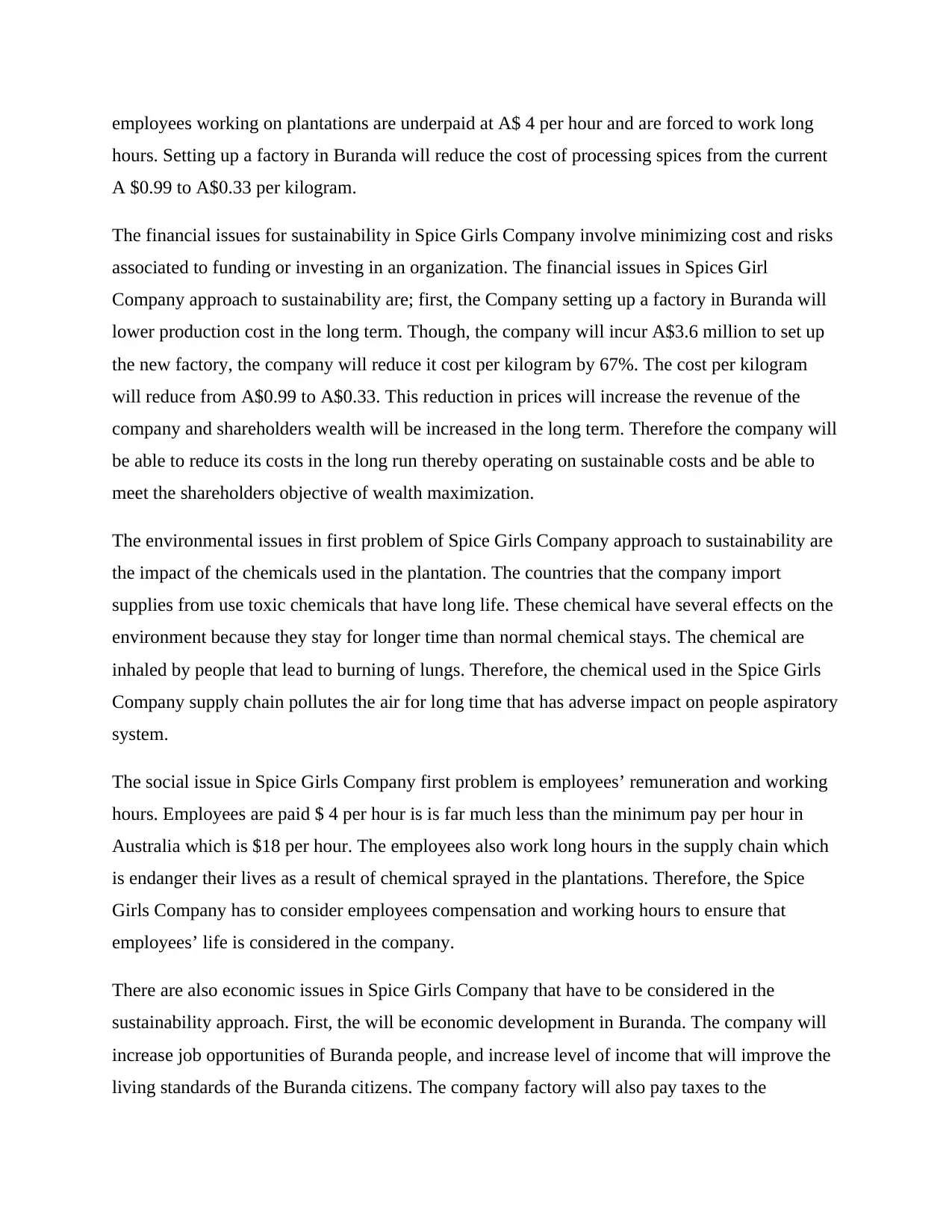
employees working on plantations are underpaid at A$ 4 per hour and are forced to work long
hours. Setting up a factory in Buranda will reduce the cost of processing spices from the current
A $0.99 to A$0.33 per kilogram.
The financial issues for sustainability in Spice Girls Company involve minimizing cost and risks
associated to funding or investing in an organization. The financial issues in Spices Girl
Company approach to sustainability are; first, the Company setting up a factory in Buranda will
lower production cost in the long term. Though, the company will incur A$3.6 million to set up
the new factory, the company will reduce it cost per kilogram by 67%. The cost per kilogram
will reduce from A$0.99 to A$0.33. This reduction in prices will increase the revenue of the
company and shareholders wealth will be increased in the long term. Therefore the company will
be able to reduce its costs in the long run thereby operating on sustainable costs and be able to
meet the shareholders objective of wealth maximization.
The environmental issues in first problem of Spice Girls Company approach to sustainability are
the impact of the chemicals used in the plantation. The countries that the company import
supplies from use toxic chemicals that have long life. These chemical have several effects on the
environment because they stay for longer time than normal chemical stays. The chemical are
inhaled by people that lead to burning of lungs. Therefore, the chemical used in the Spice Girls
Company supply chain pollutes the air for long time that has adverse impact on people aspiratory
system.
The social issue in Spice Girls Company first problem is employees’ remuneration and working
hours. Employees are paid $ 4 per hour is is far much less than the minimum pay per hour in
Australia which is $18 per hour. The employees also work long hours in the supply chain which
is endanger their lives as a result of chemical sprayed in the plantations. Therefore, the Spice
Girls Company has to consider employees compensation and working hours to ensure that
employees’ life is considered in the company.
There are also economic issues in Spice Girls Company that have to be considered in the
sustainability approach. First, the will be economic development in Buranda. The company will
increase job opportunities of Buranda people, and increase level of income that will improve the
living standards of the Buranda citizens. The company factory will also pay taxes to the
hours. Setting up a factory in Buranda will reduce the cost of processing spices from the current
A $0.99 to A$0.33 per kilogram.
The financial issues for sustainability in Spice Girls Company involve minimizing cost and risks
associated to funding or investing in an organization. The financial issues in Spices Girl
Company approach to sustainability are; first, the Company setting up a factory in Buranda will
lower production cost in the long term. Though, the company will incur A$3.6 million to set up
the new factory, the company will reduce it cost per kilogram by 67%. The cost per kilogram
will reduce from A$0.99 to A$0.33. This reduction in prices will increase the revenue of the
company and shareholders wealth will be increased in the long term. Therefore the company will
be able to reduce its costs in the long run thereby operating on sustainable costs and be able to
meet the shareholders objective of wealth maximization.
The environmental issues in first problem of Spice Girls Company approach to sustainability are
the impact of the chemicals used in the plantation. The countries that the company import
supplies from use toxic chemicals that have long life. These chemical have several effects on the
environment because they stay for longer time than normal chemical stays. The chemical are
inhaled by people that lead to burning of lungs. Therefore, the chemical used in the Spice Girls
Company supply chain pollutes the air for long time that has adverse impact on people aspiratory
system.
The social issue in Spice Girls Company first problem is employees’ remuneration and working
hours. Employees are paid $ 4 per hour is is far much less than the minimum pay per hour in
Australia which is $18 per hour. The employees also work long hours in the supply chain which
is endanger their lives as a result of chemical sprayed in the plantations. Therefore, the Spice
Girls Company has to consider employees compensation and working hours to ensure that
employees’ life is considered in the company.
There are also economic issues in Spice Girls Company that have to be considered in the
sustainability approach. First, the will be economic development in Buranda. The company will
increase job opportunities of Buranda people, and increase level of income that will improve the
living standards of the Buranda citizens. The company factory will also pay taxes to the
⊘ This is a preview!⊘
Do you want full access?
Subscribe today to unlock all pages.

Trusted by 1+ million students worldwide
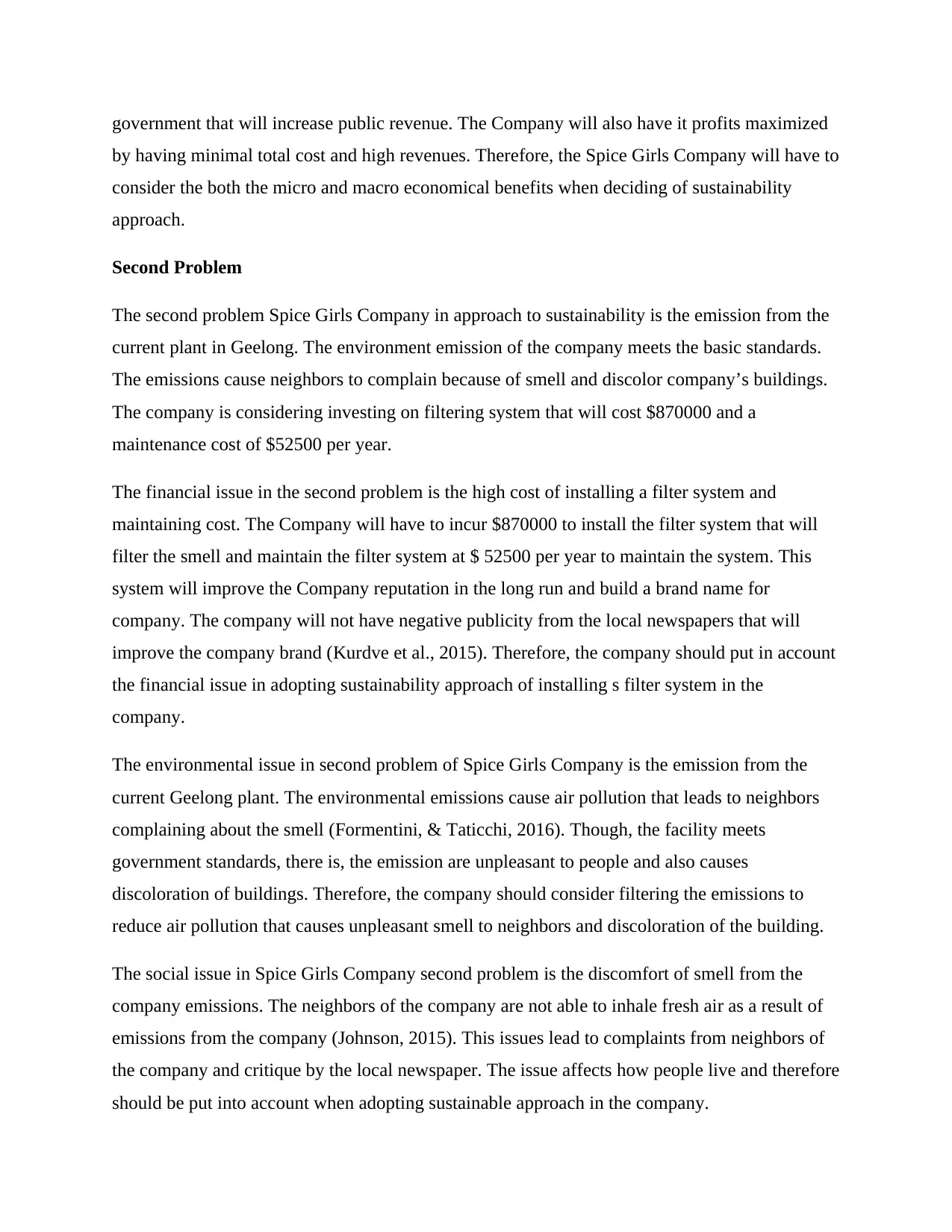
government that will increase public revenue. The Company will also have it profits maximized
by having minimal total cost and high revenues. Therefore, the Spice Girls Company will have to
consider the both the micro and macro economical benefits when deciding of sustainability
approach.
Second Problem
The second problem Spice Girls Company in approach to sustainability is the emission from the
current plant in Geelong. The environment emission of the company meets the basic standards.
The emissions cause neighbors to complain because of smell and discolor company’s buildings.
The company is considering investing on filtering system that will cost $870000 and a
maintenance cost of $52500 per year.
The financial issue in the second problem is the high cost of installing a filter system and
maintaining cost. The Company will have to incur $870000 to install the filter system that will
filter the smell and maintain the filter system at $ 52500 per year to maintain the system. This
system will improve the Company reputation in the long run and build a brand name for
company. The company will not have negative publicity from the local newspapers that will
improve the company brand (Kurdve et al., 2015). Therefore, the company should put in account
the financial issue in adopting sustainability approach of installing s filter system in the
company.
The environmental issue in second problem of Spice Girls Company is the emission from the
current Geelong plant. The environmental emissions cause air pollution that leads to neighbors
complaining about the smell (Formentini, & Taticchi, 2016). Though, the facility meets
government standards, there is, the emission are unpleasant to people and also causes
discoloration of buildings. Therefore, the company should consider filtering the emissions to
reduce air pollution that causes unpleasant smell to neighbors and discoloration of the building.
The social issue in Spice Girls Company second problem is the discomfort of smell from the
company emissions. The neighbors of the company are not able to inhale fresh air as a result of
emissions from the company (Johnson, 2015). This issues lead to complaints from neighbors of
the company and critique by the local newspaper. The issue affects how people live and therefore
should be put into account when adopting sustainable approach in the company.
by having minimal total cost and high revenues. Therefore, the Spice Girls Company will have to
consider the both the micro and macro economical benefits when deciding of sustainability
approach.
Second Problem
The second problem Spice Girls Company in approach to sustainability is the emission from the
current plant in Geelong. The environment emission of the company meets the basic standards.
The emissions cause neighbors to complain because of smell and discolor company’s buildings.
The company is considering investing on filtering system that will cost $870000 and a
maintenance cost of $52500 per year.
The financial issue in the second problem is the high cost of installing a filter system and
maintaining cost. The Company will have to incur $870000 to install the filter system that will
filter the smell and maintain the filter system at $ 52500 per year to maintain the system. This
system will improve the Company reputation in the long run and build a brand name for
company. The company will not have negative publicity from the local newspapers that will
improve the company brand (Kurdve et al., 2015). Therefore, the company should put in account
the financial issue in adopting sustainability approach of installing s filter system in the
company.
The environmental issue in second problem of Spice Girls Company is the emission from the
current Geelong plant. The environmental emissions cause air pollution that leads to neighbors
complaining about the smell (Formentini, & Taticchi, 2016). Though, the facility meets
government standards, there is, the emission are unpleasant to people and also causes
discoloration of buildings. Therefore, the company should consider filtering the emissions to
reduce air pollution that causes unpleasant smell to neighbors and discoloration of the building.
The social issue in Spice Girls Company second problem is the discomfort of smell from the
company emissions. The neighbors of the company are not able to inhale fresh air as a result of
emissions from the company (Johnson, 2015). This issues lead to complaints from neighbors of
the company and critique by the local newspaper. The issue affects how people live and therefore
should be put into account when adopting sustainable approach in the company.
Paraphrase This Document
Need a fresh take? Get an instant paraphrase of this document with our AI Paraphraser
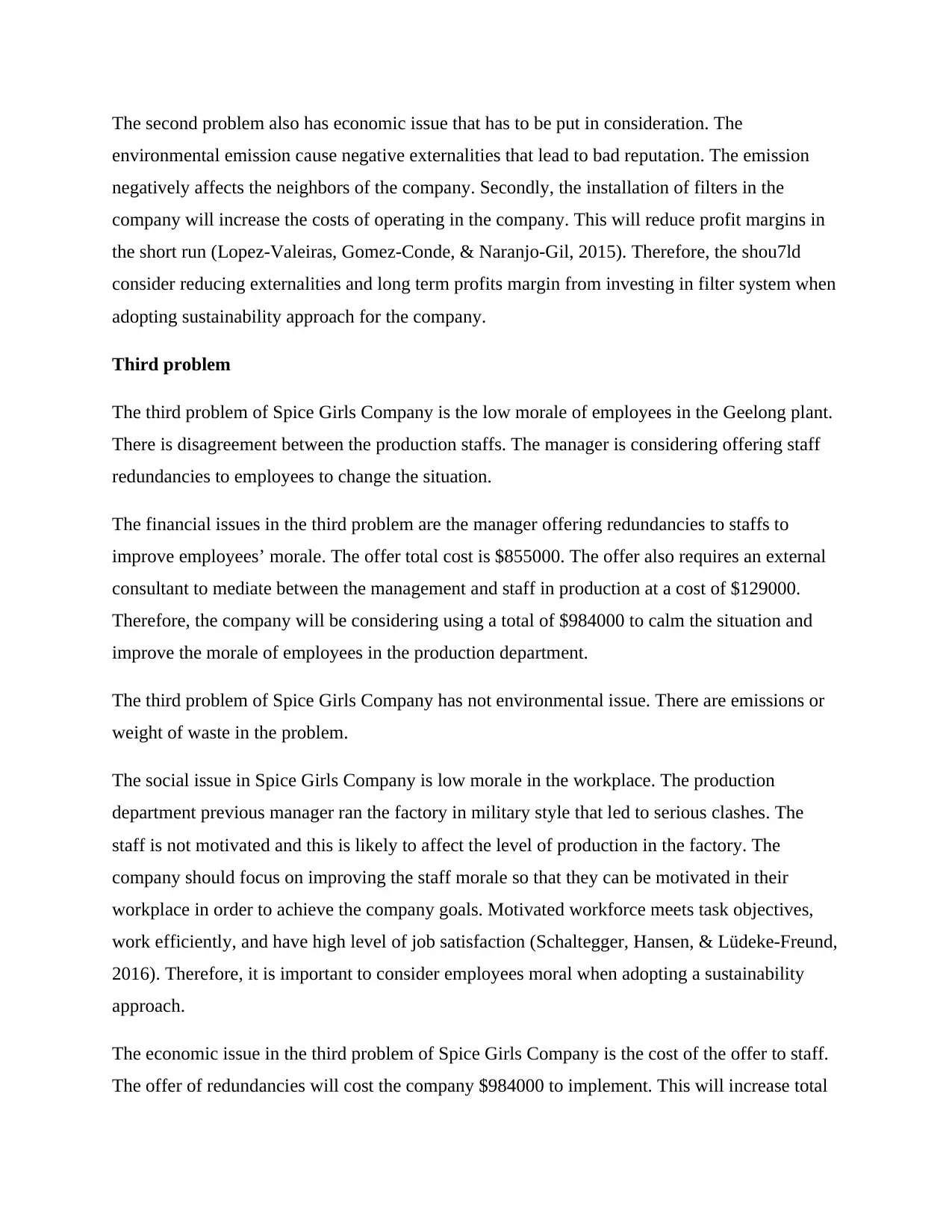
The second problem also has economic issue that has to be put in consideration. The
environmental emission cause negative externalities that lead to bad reputation. The emission
negatively affects the neighbors of the company. Secondly, the installation of filters in the
company will increase the costs of operating in the company. This will reduce profit margins in
the short run (Lopez-Valeiras, Gomez-Conde, & Naranjo-Gil, 2015). Therefore, the shou7ld
consider reducing externalities and long term profits margin from investing in filter system when
adopting sustainability approach for the company.
Third problem
The third problem of Spice Girls Company is the low morale of employees in the Geelong plant.
There is disagreement between the production staffs. The manager is considering offering staff
redundancies to employees to change the situation.
The financial issues in the third problem are the manager offering redundancies to staffs to
improve employees’ morale. The offer total cost is $855000. The offer also requires an external
consultant to mediate between the management and staff in production at a cost of $129000.
Therefore, the company will be considering using a total of $984000 to calm the situation and
improve the morale of employees in the production department.
The third problem of Spice Girls Company has not environmental issue. There are emissions or
weight of waste in the problem.
The social issue in Spice Girls Company is low morale in the workplace. The production
department previous manager ran the factory in military style that led to serious clashes. The
staff is not motivated and this is likely to affect the level of production in the factory. The
company should focus on improving the staff morale so that they can be motivated in their
workplace in order to achieve the company goals. Motivated workforce meets task objectives,
work efficiently, and have high level of job satisfaction (Schaltegger, Hansen, & Lüdeke-Freund,
2016). Therefore, it is important to consider employees moral when adopting a sustainability
approach.
The economic issue in the third problem of Spice Girls Company is the cost of the offer to staff.
The offer of redundancies will cost the company $984000 to implement. This will increase total
environmental emission cause negative externalities that lead to bad reputation. The emission
negatively affects the neighbors of the company. Secondly, the installation of filters in the
company will increase the costs of operating in the company. This will reduce profit margins in
the short run (Lopez-Valeiras, Gomez-Conde, & Naranjo-Gil, 2015). Therefore, the shou7ld
consider reducing externalities and long term profits margin from investing in filter system when
adopting sustainability approach for the company.
Third problem
The third problem of Spice Girls Company is the low morale of employees in the Geelong plant.
There is disagreement between the production staffs. The manager is considering offering staff
redundancies to employees to change the situation.
The financial issues in the third problem are the manager offering redundancies to staffs to
improve employees’ morale. The offer total cost is $855000. The offer also requires an external
consultant to mediate between the management and staff in production at a cost of $129000.
Therefore, the company will be considering using a total of $984000 to calm the situation and
improve the morale of employees in the production department.
The third problem of Spice Girls Company has not environmental issue. There are emissions or
weight of waste in the problem.
The social issue in Spice Girls Company is low morale in the workplace. The production
department previous manager ran the factory in military style that led to serious clashes. The
staff is not motivated and this is likely to affect the level of production in the factory. The
company should focus on improving the staff morale so that they can be motivated in their
workplace in order to achieve the company goals. Motivated workforce meets task objectives,
work efficiently, and have high level of job satisfaction (Schaltegger, Hansen, & Lüdeke-Freund,
2016). Therefore, it is important to consider employees moral when adopting a sustainability
approach.
The economic issue in the third problem of Spice Girls Company is the cost of the offer to staff.
The offer of redundancies will cost the company $984000 to implement. This will increase total
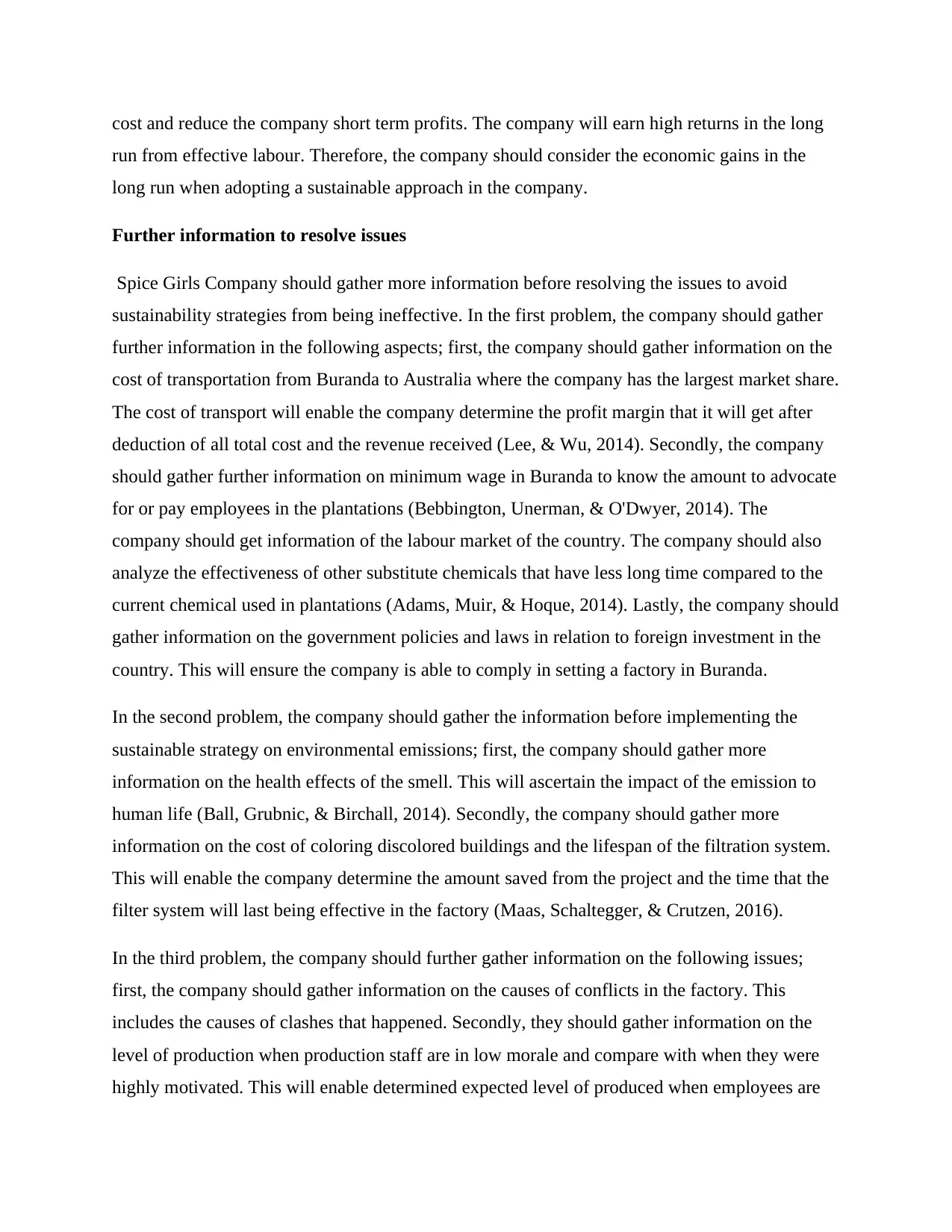
cost and reduce the company short term profits. The company will earn high returns in the long
run from effective labour. Therefore, the company should consider the economic gains in the
long run when adopting a sustainable approach in the company.
Further information to resolve issues
Spice Girls Company should gather more information before resolving the issues to avoid
sustainability strategies from being ineffective. In the first problem, the company should gather
further information in the following aspects; first, the company should gather information on the
cost of transportation from Buranda to Australia where the company has the largest market share.
The cost of transport will enable the company determine the profit margin that it will get after
deduction of all total cost and the revenue received (Lee, & Wu, 2014). Secondly, the company
should gather further information on minimum wage in Buranda to know the amount to advocate
for or pay employees in the plantations (Bebbington, Unerman, & O'Dwyer, 2014). The
company should get information of the labour market of the country. The company should also
analyze the effectiveness of other substitute chemicals that have less long time compared to the
current chemical used in plantations (Adams, Muir, & Hoque, 2014). Lastly, the company should
gather information on the government policies and laws in relation to foreign investment in the
country. This will ensure the company is able to comply in setting a factory in Buranda.
In the second problem, the company should gather the information before implementing the
sustainable strategy on environmental emissions; first, the company should gather more
information on the health effects of the smell. This will ascertain the impact of the emission to
human life (Ball, Grubnic, & Birchall, 2014). Secondly, the company should gather more
information on the cost of coloring discolored buildings and the lifespan of the filtration system.
This will enable the company determine the amount saved from the project and the time that the
filter system will last being effective in the factory (Maas, Schaltegger, & Crutzen, 2016).
In the third problem, the company should further gather information on the following issues;
first, the company should gather information on the causes of conflicts in the factory. This
includes the causes of clashes that happened. Secondly, they should gather information on the
level of production when production staff are in low morale and compare with when they were
highly motivated. This will enable determined expected level of produced when employees are
run from effective labour. Therefore, the company should consider the economic gains in the
long run when adopting a sustainable approach in the company.
Further information to resolve issues
Spice Girls Company should gather more information before resolving the issues to avoid
sustainability strategies from being ineffective. In the first problem, the company should gather
further information in the following aspects; first, the company should gather information on the
cost of transportation from Buranda to Australia where the company has the largest market share.
The cost of transport will enable the company determine the profit margin that it will get after
deduction of all total cost and the revenue received (Lee, & Wu, 2014). Secondly, the company
should gather further information on minimum wage in Buranda to know the amount to advocate
for or pay employees in the plantations (Bebbington, Unerman, & O'Dwyer, 2014). The
company should get information of the labour market of the country. The company should also
analyze the effectiveness of other substitute chemicals that have less long time compared to the
current chemical used in plantations (Adams, Muir, & Hoque, 2014). Lastly, the company should
gather information on the government policies and laws in relation to foreign investment in the
country. This will ensure the company is able to comply in setting a factory in Buranda.
In the second problem, the company should gather the information before implementing the
sustainable strategy on environmental emissions; first, the company should gather more
information on the health effects of the smell. This will ascertain the impact of the emission to
human life (Ball, Grubnic, & Birchall, 2014). Secondly, the company should gather more
information on the cost of coloring discolored buildings and the lifespan of the filtration system.
This will enable the company determine the amount saved from the project and the time that the
filter system will last being effective in the factory (Maas, Schaltegger, & Crutzen, 2016).
In the third problem, the company should further gather information on the following issues;
first, the company should gather information on the causes of conflicts in the factory. This
includes the causes of clashes that happened. Secondly, they should gather information on the
level of production when production staff are in low morale and compare with when they were
highly motivated. This will enable determined expected level of produced when employees are
⊘ This is a preview!⊘
Do you want full access?
Subscribe today to unlock all pages.

Trusted by 1+ million students worldwide
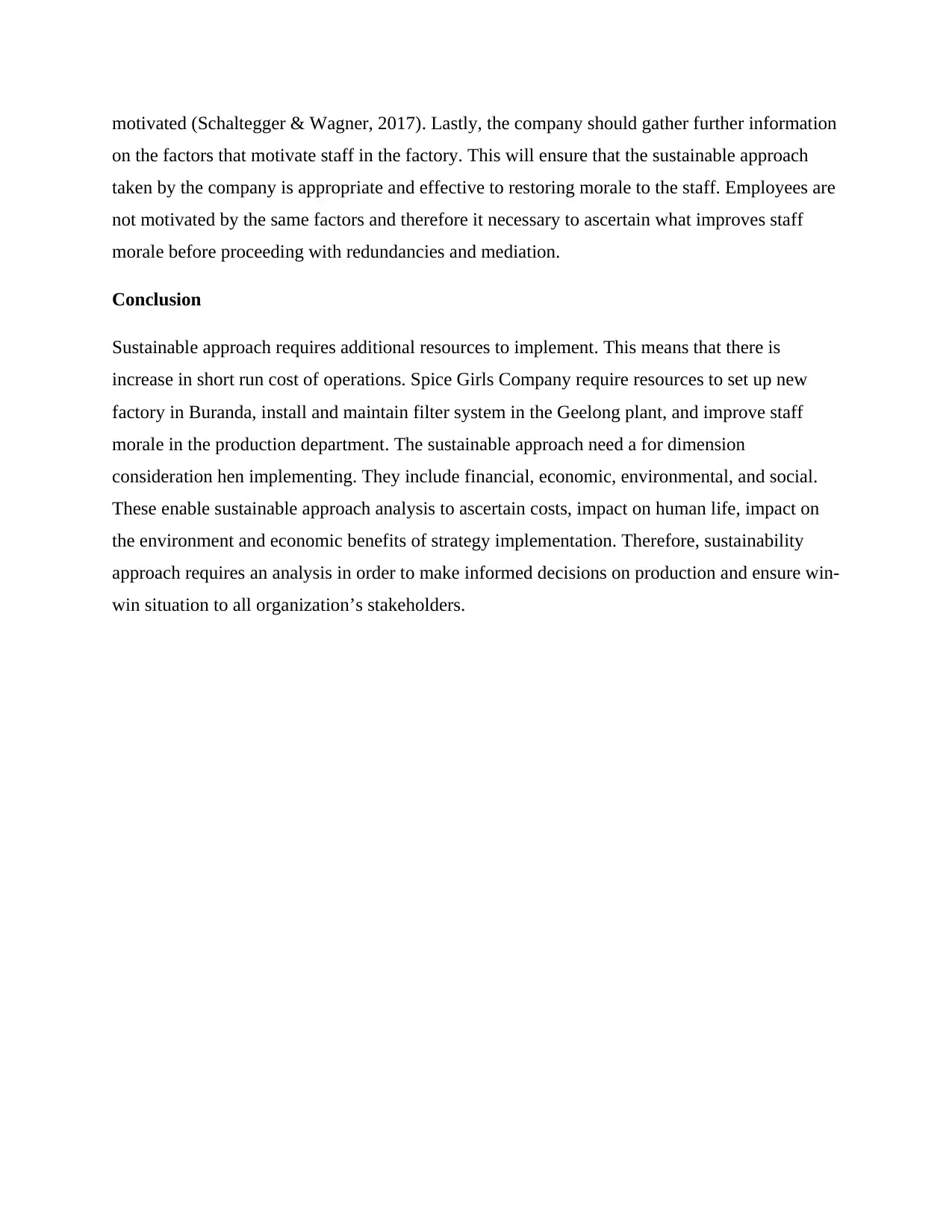
motivated (Schaltegger & Wagner, 2017). Lastly, the company should gather further information
on the factors that motivate staff in the factory. This will ensure that the sustainable approach
taken by the company is appropriate and effective to restoring morale to the staff. Employees are
not motivated by the same factors and therefore it necessary to ascertain what improves staff
morale before proceeding with redundancies and mediation.
Conclusion
Sustainable approach requires additional resources to implement. This means that there is
increase in short run cost of operations. Spice Girls Company require resources to set up new
factory in Buranda, install and maintain filter system in the Geelong plant, and improve staff
morale in the production department. The sustainable approach need a for dimension
consideration hen implementing. They include financial, economic, environmental, and social.
These enable sustainable approach analysis to ascertain costs, impact on human life, impact on
the environment and economic benefits of strategy implementation. Therefore, sustainability
approach requires an analysis in order to make informed decisions on production and ensure win-
win situation to all organization’s stakeholders.
on the factors that motivate staff in the factory. This will ensure that the sustainable approach
taken by the company is appropriate and effective to restoring morale to the staff. Employees are
not motivated by the same factors and therefore it necessary to ascertain what improves staff
morale before proceeding with redundancies and mediation.
Conclusion
Sustainable approach requires additional resources to implement. This means that there is
increase in short run cost of operations. Spice Girls Company require resources to set up new
factory in Buranda, install and maintain filter system in the Geelong plant, and improve staff
morale in the production department. The sustainable approach need a for dimension
consideration hen implementing. They include financial, economic, environmental, and social.
These enable sustainable approach analysis to ascertain costs, impact on human life, impact on
the environment and economic benefits of strategy implementation. Therefore, sustainability
approach requires an analysis in order to make informed decisions on production and ensure win-
win situation to all organization’s stakeholders.
Paraphrase This Document
Need a fresh take? Get an instant paraphrase of this document with our AI Paraphraser
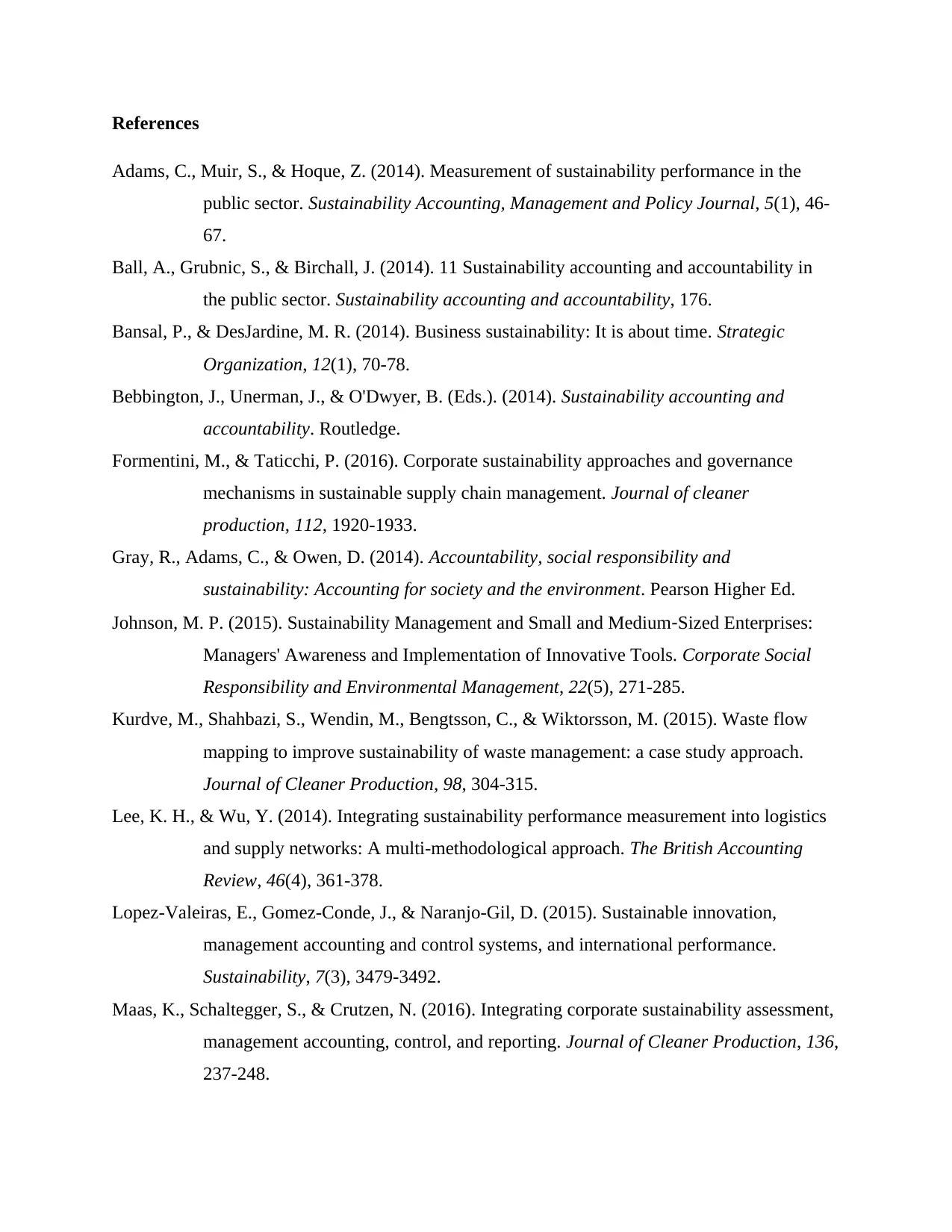
References
Adams, C., Muir, S., & Hoque, Z. (2014). Measurement of sustainability performance in the
public sector. Sustainability Accounting, Management and Policy Journal, 5(1), 46-
67.
Ball, A., Grubnic, S., & Birchall, J. (2014). 11 Sustainability accounting and accountability in
the public sector. Sustainability accounting and accountability, 176.
Bansal, P., & DesJardine, M. R. (2014). Business sustainability: It is about time. Strategic
Organization, 12(1), 70-78.
Bebbington, J., Unerman, J., & O'Dwyer, B. (Eds.). (2014). Sustainability accounting and
accountability. Routledge.
Formentini, M., & Taticchi, P. (2016). Corporate sustainability approaches and governance
mechanisms in sustainable supply chain management. Journal of cleaner
production, 112, 1920-1933.
Gray, R., Adams, C., & Owen, D. (2014). Accountability, social responsibility and
sustainability: Accounting for society and the environment. Pearson Higher Ed.
Johnson, M. P. (2015). Sustainability Management and Small and Medium‐Sized Enterprises:
Managers' Awareness and Implementation of Innovative Tools. Corporate Social
Responsibility and Environmental Management, 22(5), 271-285.
Kurdve, M., Shahbazi, S., Wendin, M., Bengtsson, C., & Wiktorsson, M. (2015). Waste flow
mapping to improve sustainability of waste management: a case study approach.
Journal of Cleaner Production, 98, 304-315.
Lee, K. H., & Wu, Y. (2014). Integrating sustainability performance measurement into logistics
and supply networks: A multi-methodological approach. The British Accounting
Review, 46(4), 361-378.
Lopez-Valeiras, E., Gomez-Conde, J., & Naranjo-Gil, D. (2015). Sustainable innovation,
management accounting and control systems, and international performance.
Sustainability, 7(3), 3479-3492.
Maas, K., Schaltegger, S., & Crutzen, N. (2016). Integrating corporate sustainability assessment,
management accounting, control, and reporting. Journal of Cleaner Production, 136,
237-248.
Adams, C., Muir, S., & Hoque, Z. (2014). Measurement of sustainability performance in the
public sector. Sustainability Accounting, Management and Policy Journal, 5(1), 46-
67.
Ball, A., Grubnic, S., & Birchall, J. (2014). 11 Sustainability accounting and accountability in
the public sector. Sustainability accounting and accountability, 176.
Bansal, P., & DesJardine, M. R. (2014). Business sustainability: It is about time. Strategic
Organization, 12(1), 70-78.
Bebbington, J., Unerman, J., & O'Dwyer, B. (Eds.). (2014). Sustainability accounting and
accountability. Routledge.
Formentini, M., & Taticchi, P. (2016). Corporate sustainability approaches and governance
mechanisms in sustainable supply chain management. Journal of cleaner
production, 112, 1920-1933.
Gray, R., Adams, C., & Owen, D. (2014). Accountability, social responsibility and
sustainability: Accounting for society and the environment. Pearson Higher Ed.
Johnson, M. P. (2015). Sustainability Management and Small and Medium‐Sized Enterprises:
Managers' Awareness and Implementation of Innovative Tools. Corporate Social
Responsibility and Environmental Management, 22(5), 271-285.
Kurdve, M., Shahbazi, S., Wendin, M., Bengtsson, C., & Wiktorsson, M. (2015). Waste flow
mapping to improve sustainability of waste management: a case study approach.
Journal of Cleaner Production, 98, 304-315.
Lee, K. H., & Wu, Y. (2014). Integrating sustainability performance measurement into logistics
and supply networks: A multi-methodological approach. The British Accounting
Review, 46(4), 361-378.
Lopez-Valeiras, E., Gomez-Conde, J., & Naranjo-Gil, D. (2015). Sustainable innovation,
management accounting and control systems, and international performance.
Sustainability, 7(3), 3479-3492.
Maas, K., Schaltegger, S., & Crutzen, N. (2016). Integrating corporate sustainability assessment,
management accounting, control, and reporting. Journal of Cleaner Production, 136,
237-248.
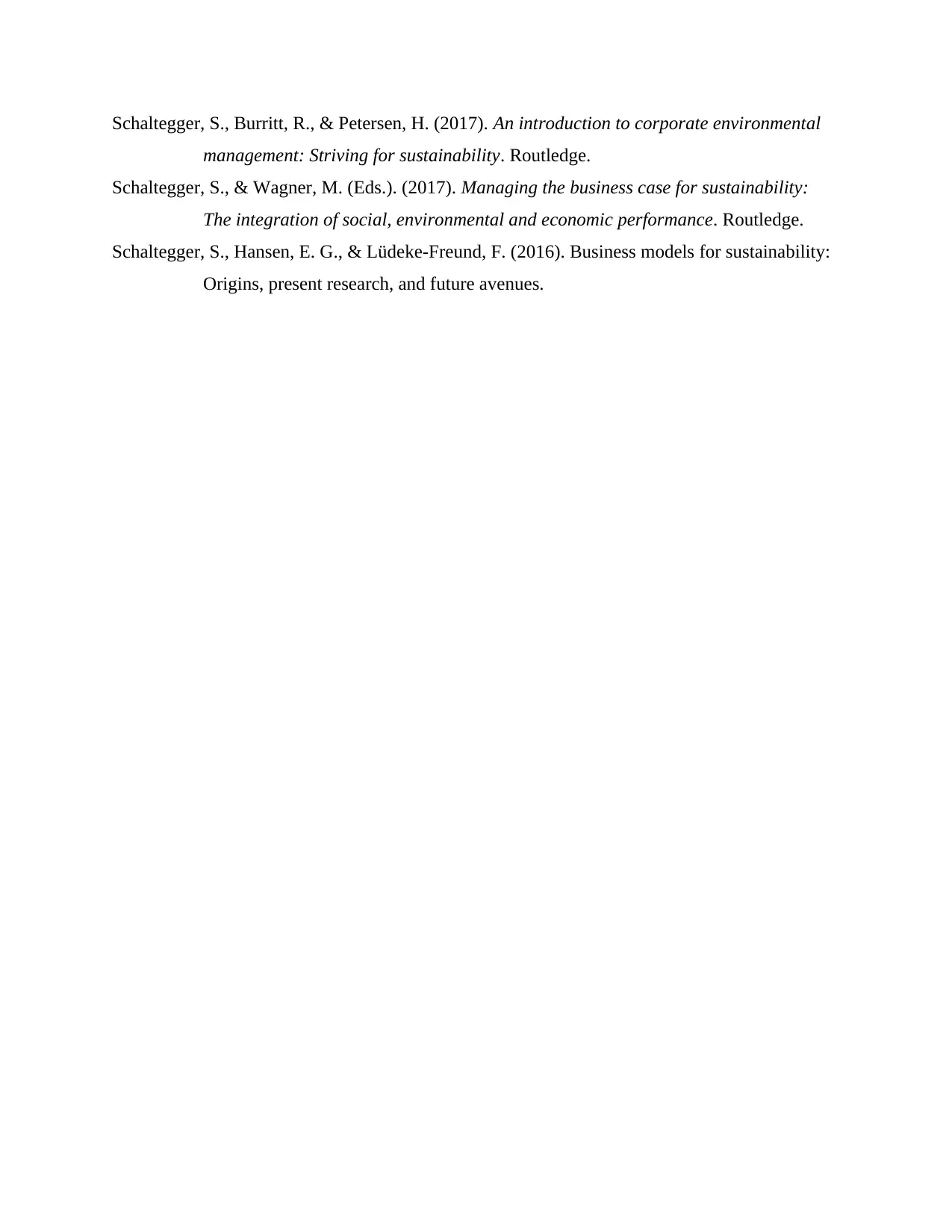
Schaltegger, S., Burritt, R., & Petersen, H. (2017). An introduction to corporate environmental
management: Striving for sustainability. Routledge.
Schaltegger, S., & Wagner, M. (Eds.). (2017). Managing the business case for sustainability:
The integration of social, environmental and economic performance. Routledge.
Schaltegger, S., Hansen, E. G., & Lüdeke-Freund, F. (2016). Business models for sustainability:
Origins, present research, and future avenues.
management: Striving for sustainability. Routledge.
Schaltegger, S., & Wagner, M. (Eds.). (2017). Managing the business case for sustainability:
The integration of social, environmental and economic performance. Routledge.
Schaltegger, S., Hansen, E. G., & Lüdeke-Freund, F. (2016). Business models for sustainability:
Origins, present research, and future avenues.
⊘ This is a preview!⊘
Do you want full access?
Subscribe today to unlock all pages.

Trusted by 1+ million students worldwide
1 out of 9
Related Documents
Your All-in-One AI-Powered Toolkit for Academic Success.
+13062052269
info@desklib.com
Available 24*7 on WhatsApp / Email
![[object Object]](/_next/static/media/star-bottom.7253800d.svg)
Unlock your academic potential
Copyright © 2020–2025 A2Z Services. All Rights Reserved. Developed and managed by ZUCOL.





